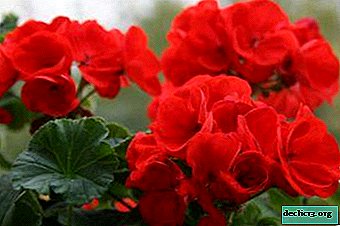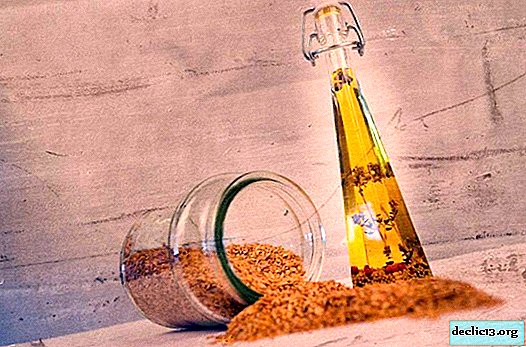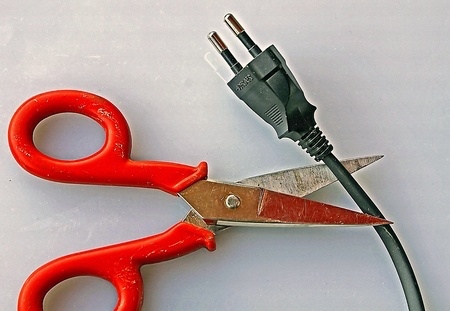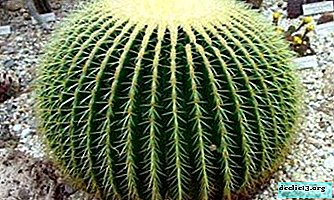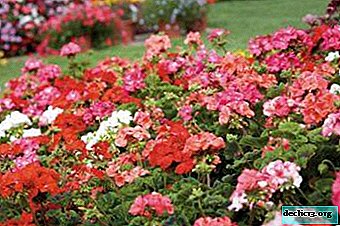In simple terms, how to distinguish a root from a peduncle in an orchid
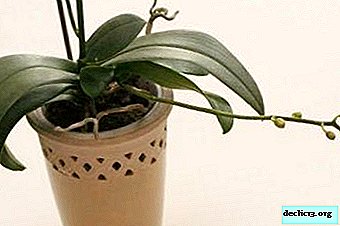
The most beautiful thing in indoor orchids is their flowering. Unfortunately, waiting for this period sometimes takes quite a while. And finally, the peduncle that has appeared is easy to confuse with the root or baby. What does a flower stalk look like?
How is it different from a new root or baby? And the most important thing is how to care for the plant while the peduncle develops, we will describe in detail in the article. We also recommend watching a useful and informative video on this topic.
General information
An orchid flower stalk is an escape on which flowers form. On one peduncle there can be more than 50 buds! But this is with an adult and a large orchid. The flower stalk looks like a long and flexible stem, on which later, after it grows to a certain length, orchid buds will begin to blossom. Some flower growers use the term "flower stalk" in a narrower semantic meaning and understand by it the part of the stem part of the plant on which the flowers are directly located.
ATTENTION: Peduncles can grow in the most bizarre way, both straight and bending in all directions. Sometimes they are bent, like a pig’s tail, twisted into rings.The main rule is that the flower stalk always grows from a growth point. Read more about the appearance and development of the peduncle here.
Why is it important to determine what kind of new processes a plant has?
Whatever appears in an orchid, for a gardener who loves his plant, it is always a joy. A new spine, baby, or peduncle promising lush flowering is equally good. But to distinguish the peduncle from other parts is still worth.
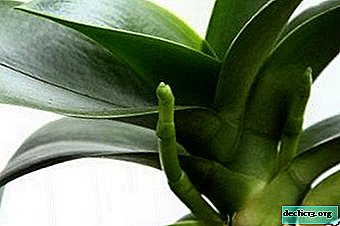 Thus, you will understand that the plant needs to be carefully looked after. After all, an orchid in the flowering period requires special attention, periodically - top dressing. The watering schedule is also changing.
Thus, you will understand that the plant needs to be carefully looked after. After all, an orchid in the flowering period requires special attention, periodically - top dressing. The watering schedule is also changing.- It is not always worth letting the plant bloom. If it is not healthy, or has just survived a difficult transplant (for example, due to rotten roots), the best solution would be to cut the peduncle to give strength directly to growth.
- No one has canceled a simple interest. And the orchid, as you know, is a leisurely flower, and it will take a long time to grow an incomprehensible process.
What does he look like?
Throughout its life cycle, the peduncle is greatly modified. It can be of two types.
New
Usually it grows from the sinus of leaves - the place where the leaf comes close to the stem. He breaks through the sheet. Peduncle usually flat, but with a pointed tip, having a stepped shape. It is light green or saturated green, grows up or sideways, heading towards the sun.
IMPORTANT: On the peduncle, you can immediately see the scales. From the beginning of the growth of the peduncle to the opening of the first buds on it usually takes about a couple of months, so be patient.Old
Gradually pecking flower stalk will grow, turning into a long flexible stem, juicy and green. Then the buds will open on it. Peduncles orchids are very fragile, they are easy to break. So it’s better to tie up the peduncle as it grows.
When the orchid fades, the peduncle will begin to change: it will change color to yellow or brown. Sometimes the color can even change to red or bright purple. After that, the old flower stalk dries and falls off. But it’s better not to bring it to this, and prune the flower stalk immediately after the last flower withers - this will save the plant’s strength.
But sometimes it’s difficult to understand if the flowering period has already ended. Pay attention to the tip of the peduncle. While it is green - this indicates that it is growing, it can increase in size and produce new buds. But if the tip turned yellow, blackened or withered - flowering came to an end.
Trim or not pruning flower stalk - you can decide individually. The fact is that the old peduncle can bloom anew or form a baby. On the other hand, old flower stalks inhibit the development of new ones and generally weaken the plant. We discussed the issue of caring for a faded orchid in more detail here.
How to distinguish from the root?
A newly emerged peduncle is easy to confuse with a root or baby. Be guided by such differences:
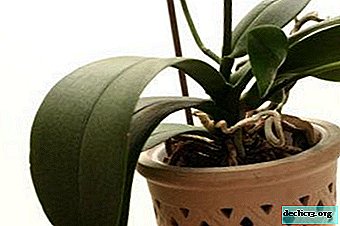 Flower stalk:
Flower stalk:- Appears strictly from the neck of one of the freshly formed leaves.
- The tip is sharp and has a complex, stepped, cone-like shape.
- The shape of the tip is somewhat reminiscent of a closed beak.
- The form of the peduncle itself is something flattened, rather flat.
- Stretches up, less often sideways. The peduncle will fall down later, under the weight of the formed buds, if it is not tied in time.
- Root:
- Most often grows outside, and not in the sinus of leaves. It can grow from anywhere in the neck of an orchid, including from the middle of the leaf.
- The tip is bright, and then comes the bright velamen.
- The shape of the tip is round, smooth, without scales.
- The shape of the kidney is uniformly rounded, conical.
- It can grow in any direction: up, sideways, but more often tends to down.
Watch the video about the difference between the peduncle and the orchid root:
How is the peduncle different from the baby?
What does the baby look like:
- It grows in the place of a peduncle, next to the central vein of the leaf.
- The shape of the tip is similar to an open beak.
- Directed up.
It is almost impossible to distinguish a peduncle from a baby. It is necessary to wait until the shoot increases to at least 3 cm, then it will already be possible to understand something by the shape of the tip. The ability to instantly recognize what exactly your orchid grows comes with experience.
Watch the video about the difference between a baby and an orchid flower stalk:
How to care?
After the peduncle is released, the orchid can bloom for up to a year, gradually increasing it, and dissolving the bud after the bud. With another scenario, the orchid will simultaneously reveal many flowers, which will soon fade.
You can extend flowering by properly caring for an orchid with a peduncle:
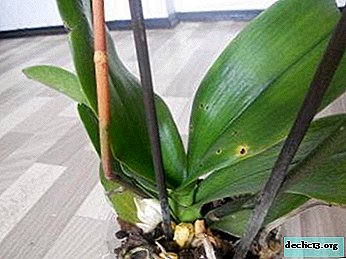 Do not allow the flower stalk to remain in the draft. For him, both cold and warm airflow are equally destructive, so leave it behind the battery and the air conditioner. An orchid that has stood in a draft for a day can dump all the flowers.
Do not allow the flower stalk to remain in the draft. For him, both cold and warm airflow are equally destructive, so leave it behind the battery and the air conditioner. An orchid that has stood in a draft for a day can dump all the flowers.- Once you determine that it is a flower stalk, not a baby or root - forget about transplanting for a while. While there is flowering, you can’t touch the orchid. This is especially true of the capricious in terms of transplanting phalaenopsis.
- Fix the peduncle on a special holder, or tie it up somehow. Of course, no one ties up flower stalks in nature, and they fall down in a spectacular cascade. But at home, an unsecured peduncle is easy to damage. Especially if there are pets, always ready to try a novelty on the tooth.TIP: A plastic or wooden support, to which the peduncle is attached with a special clip, can be a reliable fastening. It is possible to simply tie with thin satin ribbons or strong threads - this is even more aesthetic. Do not overtighten the thread so that it does not cut the juicy peduncle.
- Provide the peduncle with adequate lighting. If there is not enough natural light - light up. Otherwise, it will reach for the light, grow after it, and you will get a spiral instead of a straight arrow. Moreover, only with full lighting the peduncle will develop normally: the more light, the faster it grows.
- Watering the orchid during the growth of the peduncle is necessary according to the previous scheme. But with the beginning of flowering - reduce watering.
- If you fed an orchid, then continue feeding until the formation of the first flower.
- If the flower stalk begins to dry quickly after flowering, cut it with sharp scissors. You need to leave a small "stump". Sprinkle the place of the cut for disinfection with crushed charcoal or ground cinnamon. The remaining stump will be hollow inside. If water begins to stagnate in it, this will lead to rotting of the trunk. It is better to immediately seal the hole, for example with beeswax.
- If the peduncle remains green, do not rush to cut it. Or cut the peduncle immediately above the third node - this stimulates repeated flowering. But this advice is better not to use if the plant is still young - it does not have enough strength for a baby or a new flowering.
Watch a video about caring for an orchid with a peduncle:
Conclusion
Whatever appears on your orchid is good, because it means that the plant has fully adapted in your apartment and is ready for new growth. Now you know how to distinguish the peduncle from the baby and the root, how to care for it and, most importantly, how soon to wait for flowering.
Well, if the orchid is in no hurry to release something (why does the peduncle not appear?), Try to stimulate it with fertilizer (if it does not get sick). And then soon, looking at the green tip of the peduncle, one can expect the lush flowering of a tropical beauty!

 Thus, you will understand that the plant needs to be carefully looked after. After all, an orchid in the flowering period requires special attention, periodically - top dressing. The watering schedule is also changing.
Thus, you will understand that the plant needs to be carefully looked after. After all, an orchid in the flowering period requires special attention, periodically - top dressing. The watering schedule is also changing. Flower stalk:
Flower stalk: Do not allow the flower stalk to remain in the draft. For him, both cold and warm airflow are equally destructive, so leave it behind the battery and the air conditioner. An orchid that has stood in a draft for a day can dump all the flowers.
Do not allow the flower stalk to remain in the draft. For him, both cold and warm airflow are equally destructive, so leave it behind the battery and the air conditioner. An orchid that has stood in a draft for a day can dump all the flowers.
